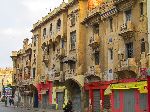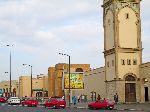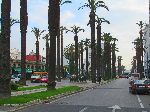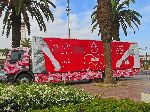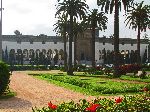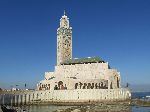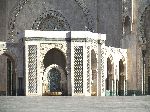|
Morocco:
West Atlas Bicycle Africa / Ibike Tours |
|||
 |
Atlantic Coast: Casablanca | ||
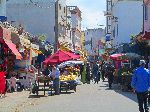 |
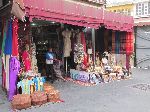 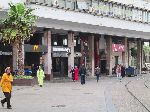 Casablanca
is the economic, finance and business center of Morocco and has many features of
a big city (government institutions, high-rise office buildings, markets, parks,
schools, apartment blocks, fast food restaurants, cafés,
etc) but very few that would elicit glowing superlatives. It is working city! Casablanca
is the economic, finance and business center of Morocco and has many features of
a big city (government institutions, high-rise office buildings, markets, parks,
schools, apartment blocks, fast food restaurants, cafés,
etc) but very few that would elicit glowing superlatives. It is working city! |
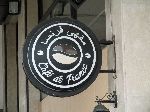 |
|
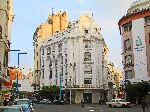 |
|
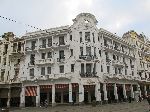 |
|
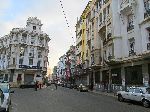 |

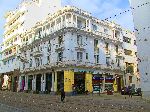

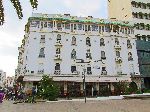 |
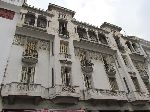 |
|
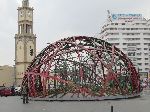 |
The
small cluster of points of interest in the "center" of town, as defined by Place
des Nations Unies. In the corner of the large plaza is a modern hemispheric
sculpture, presumably representing earth. Otherwise, Place des Nations Unies is
rather bare and hard, and surrounded by wide boulevards that it extend the
urban-desert, to make it is not very inviting.
Across the street, now integrated into the wall of the old medina, is a clock
tower (behind the hemisphere) that was the work of the French. It was
originally built in 1911, by order of the French Captain Dessigny,
Until the construction of Mosque Hassan II, it was the most emblematic buildings
in Casablanca. It was initially situated next to the old city wall, which was
destroyed a little later to give more access to the port, so the tower stood alone
in the middle of the square for several decades. It was a symbol of the French
colonial power. Dessigny's aim was to convince the inhabitants of Casablanca
of the need to get used to the pace of life in an industrial society. In 1948,
they began to demolish it, because of its precarious state of disrepair.
Forty-five years later, in
1993, it was reconstructed by the Leading off to the east from the plaza is an extension of Boulevard. Hassan I. For a couple of blocks it is a divided roadway, with a median that is landscaped with royal palms. It commemorates President Felix Houphouet Boigny, the first president of Ivory Coast (1960-1993). |
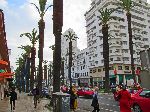 |
|
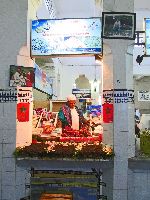 |
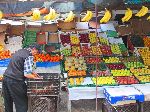

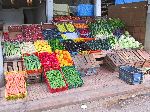
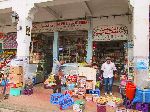 The most colorful location in Casablanca just might be the central market. Between the fruits, vegetables, and dry goods packaging, the market arguably has the highest concentration of pigment in town. |
 |
|
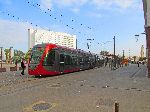  The
newest transportation option in Casablanca is the sleek modern Casablanca
Tramway. One remarkable fact of the system is that, building through a full
built-up environment, construction started in 2010 and the service was
inaugurated less than three years later (Dec 2012). Ticket prices are subsidized
by the Moroccan government and the city of Casablanca, and set at a flat rate of
6 dirhams (about US$0.60 (2015)) The
newest transportation option in Casablanca is the sleek modern Casablanca
Tramway. One remarkable fact of the system is that, building through a full
built-up environment, construction started in 2010 and the service was
inaugurated less than three years later (Dec 2012). Ticket prices are subsidized
by the Moroccan government and the city of Casablanca, and set at a flat rate of
6 dirhams (about US$0.60 (2015)) |
|||
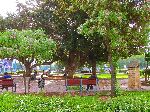 |
 In
Parc Liberte is a monument to 16 May 2003, 33 civilians were killed and
more than 100 people were injured when Casablanca was hit by a multiple suicide
bomb attack carried out by Moroccans and claimed by some to have been linked to
al-Qaeda. Twelve suicide bombers struck five locations in the city. Casablanca
is more the focus of political action than any other city in Morocco: In 2000,
40,000 women attended demonstrations calling for reforms in the legal status of
women. Again in 2007 suicide bomber hit the citizen, but this time only on
bystander was injured. A century earlier, in June 1907, there were anti-French
riots. In response, the French attacked by ship, bombarding the city from
the coast, and landing troops inside the town, which caused severe damage to the
town and 15,000 dead and wounded bodies. In
Parc Liberte is a monument to 16 May 2003, 33 civilians were killed and
more than 100 people were injured when Casablanca was hit by a multiple suicide
bomb attack carried out by Moroccans and claimed by some to have been linked to
al-Qaeda. Twelve suicide bombers struck five locations in the city. Casablanca
is more the focus of political action than any other city in Morocco: In 2000,
40,000 women attended demonstrations calling for reforms in the legal status of
women. Again in 2007 suicide bomber hit the citizen, but this time only on
bystander was injured. A century earlier, in June 1907, there were anti-French
riots. In response, the French attacked by ship, bombarding the city from
the coast, and landing troops inside the town, which caused severe damage to the
town and 15,000 dead and wounded bodies.
Parked at the edge of the park was a blood donation truck (left)-- I never saw it open or move over several days. Next door and behind the park is the Tribunal de Premiere Instance, with a more neo-Romanesque style of architecture, which is uncommon in Casablanca. |
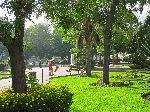 |
|
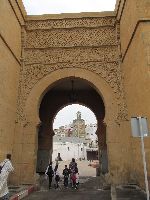 |
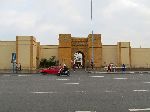
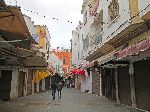
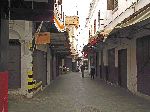
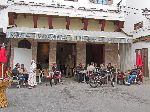 The old media in Casablanca lacks the size, color, diversity or character of those in Fes and Marrakesh or even Rabat. And to a certain extent, it lacks the tourists, as well. Once you are passed the cluster of tourist shops around the gates, you will still find the butcher, the baker and candlestick maker, or whatever. Oh, and there are cafés. The patrons are local so you figure you are looking at the health of the base economy. |
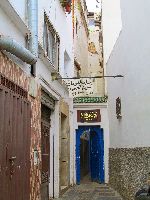 |
|
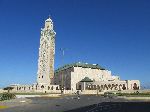 |
In outlining his vision the King said:
|
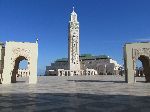 |
|
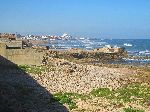 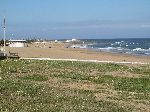 To
the north of the mosque are the port and industrial uplands, including tank farms
and petrochemical industry. Just south of the mosque there is some promenade,
ragged headlands, and narrow beaches. To
the north of the mosque are the port and industrial uplands, including tank farms
and petrochemical industry. Just south of the mosque there is some promenade,
ragged headlands, and narrow beaches. |
|||
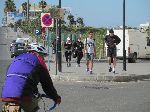  Leaving
town to the south along the coast, there are a few glimpses of the ocean. The
uplands are mostly sealed in concrete and fenced off from the sea. None-the-less
people are still out walking and jogging in the closest thing there is to a
natural environment. Leaving
town to the south along the coast, there are a few glimpses of the ocean. The
uplands are mostly sealed in concrete and fenced off from the sea. None-the-less
people are still out walking and jogging in the closest thing there is to a
natural environment.The most hideous use of the coastline is the Mall of Morocco, a particularly uninspiring, large, white box, that is partially surrounded by asphalt parking lots. |
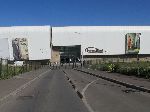 |
||
|
|
|||
|
|
|||
|
|
Unique Programs To Special Places For Memories Of A Lifetime!
"Hosted by
DreamHost - earth friendly web hosting"
|
|
